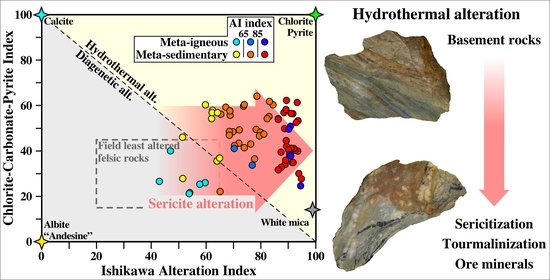Permian Hydrothermal Alteration Preserved in Polymetamorphic Basement and Constraints for Ore-genesis (Alpi Apuane, Italy)
Abstract
:1. Introduction
2. Geological Background
2.1. Regional Geology
2.2. The Paleozoic Succession of Sant’Anna Tectonic Window
2.3. The Alpi Apuane Ore District
- Pb isotope data [41], showing similar values with late Paleozoic-Triassic ores of Sardinia.
3. Materials and Methods
4. Results
4.1. “Filladi Inferiori” Fm
4.1.1. Field and Petrographic Investigation
4.1.2. Geochemistry
4.2. Fornovolasco Metarhyolite Fm
4.2.1. Field and Petrographic Investigation
4.2.2. Geochemistry
5. Discussion
5.1. Pre-Alpine Hydrothermal Alteration Recorded by the Alpi Apuane Paleozoic Rocks
- Permian metarhyolite experienced only the Alpine metamorphic event;
- the geochemistry of a calc-alkaline rhyolitic rock is less variable than that of a sedimentary protolith like the “Filladi Inferiori” Fm (Figure 5);
- several diagrams for the investigation of hydrothermal alteration were developed for igneous rocks (e.g., [63]).
- similar variability of the CCPI value for both FAF and w-FAF facies (Figure 9).
5.2. Constraint on the Permian Age of Hydrothermal Alteration
- the clear spatial distribution of hydrothermally altered “Filladi Inferiori” and Fornovolasco Metarhyolite bodies (Figure 10);
5.3. Hydrothermal Alteration and Ore Genesis
6. Conclusions
Supplementary Materials
Author Contributions
Funding
Acknowledgments
Conflicts of Interest
References
- Von Raumer, J.F.; Bussy, F.; Schaltegger, U.; Schulz, B.; Stampfli, G.M. Pre-Mesozoic Alpine basements—Their place in the European Paleozoic framework. Geol. Soc. Am. Bull. 2013, 125, 89–108. [Google Scholar] [CrossRef]
- Cavargna-Sani, M.; Epard, J.L.; Bussy, F.; Ulianov, A. Basement lithostratigraphy of the Adula nappe: Implications for Paleozoic evolution and Alpine kinematics. Int. J. Earth Sci. 2014, 103, 61–82. [Google Scholar] [CrossRef]
- Pawling, S.; Baumgartner, L.P. Geochemistry of a talc-kyanite-chloritoid shear zone within the Monte Rosa granite, Val d’Ayas, Italy. Schweiz. Mineral Petrog. Mitt. 2001, 81, 329–346. [Google Scholar] [CrossRef]
- Franz, L.; Romer, R.L.; De Capitani, C. Protoliths and phase petrology of whiteschists. Contrib. Miner. Pet. 2013, 166, 255–274. [Google Scholar] [CrossRef] [Green Version]
- Funedda, A.; Naitza, S.; Buttau, C.; Cocco, F.; Dini, A. Structural controls of ore mineralization in a polydeformed basement: Field examples from the Variscan Baccu Locci shear zone (SE Sardinia, Italy). Minerals 2018, 8, 456. [Google Scholar] [CrossRef] [Green Version]
- Kruger, F.; Geringer, G.; Havenga, A. The geology, petrology, geochronology and source region character of the layered gabbronoritic Oranjekom Complex in the Kibaran Namaqua mobile belt, South Africa. J. Afr. Earth Sci. 2000, 30, 675–687. [Google Scholar] [CrossRef]
- Vernon, R.H. A Practical Guide to Rock Microstructure; Cambridge University Press: Cambridge, UK, 2004; p. 422. [Google Scholar]
- Stanton, R.L.; Stanton, R.L. On limits to distances of movement of matter during regional metamorphism: An investigation of nine samples from high-grade metamorphic terranes. Can. Mineral. 2006, 44, 985–1024. [Google Scholar] [CrossRef]
- Bailie, R.; Gutzmer, J.; Rajesh, H. Lithogeochemistry as a tracer of the tectonic setting, lateral integrity and mineralization of a highly metamorphosed Mesoproterozoic volcanic arc sequence on the eastern margin of the Namaqua Province, South Africa. Lithos 2010, 119, 345–362. [Google Scholar] [CrossRef]
- Marroni, M.; Meneghini, F.; Pandolfi, L. A revised subduction inception model to explain the Late Cretaceous, double-vergent orogen in the precollisional Western Tethys: Evidence from the Northern Apennines. Tectonics 2017, 36, 2227–2249. [Google Scholar] [CrossRef]
- Carmignani, L.; Kligfield, R. Crustal extension in the northern Apennines: The transition from compression to extension in the Alpi Apuane Core Complex. Tectonics 1990, 9, 1275–1303. [Google Scholar] [CrossRef]
- Carmignani, L.; Decandia, F.A.; Disperati, L.; Fantozzi, P.L.; Kligfield, R.; Lazzarotto, A.; Liotta, D.; Meccheri, M. Inner Northern Apennines. In Anatomy of an Orogen: The Apennines and Adjacent Mediterranean Basins; Springer Science and Business Media LLC: Berlin/Heidelberg, Germany, 2001; pp. 197–213. [Google Scholar]
- Molli, G. Northern Apennine–Corsica orogenic system: An updated overview. Geol. Soc. Lond. Spec. Publ. 2008, 298, 413–442. [Google Scholar] [CrossRef]
- Lattanzi, P.; Benvenuti, M.; Costagliola, P.; Tanelli, G. An overview on recent research on the metallogeny of Tuscany, with special reference to the Apuane Alps. Mem. Soc. Geol. Ital. 1994, 48, 613–625. [Google Scholar]
- Ciarapica, G.; Passeri, L. The palaeogeographic duplicity of the Apennines. Boll. Soc. Geol. Ital. 2002, 1, 67–75. [Google Scholar]
- Conti, P.; Carmignani, L.; Massa, G.; Meccheri, M.; Patacca, E.; Scandone, P.; Pieruccioni, D. Note Illustrative della Carta Geologica d’Italia alla Scala 1:50.000, Foglio 249 Massa—Carrara; ISPRA: Roma, Italy, 2019; p. 290. [Google Scholar]
- Ciarapica, G.; Passeri, L. Panoramica sulla geologia delle Alpi Apuane alla luce delle più recenti ricerche. Mem. Soc. Geol. Ital. 1982, 24, 193–208. [Google Scholar]
- Conti, P.; Di Pisa, A.; Gattiglio, M.; Meccheri, M. The Pre-Alpine Basement in the Alpi Apuane (Northern Apennines, Italy). In Pre-Mesozoic Geology in the Alps; Springer Science and Business Media LLC: Berlin/Heidelberg, Germany, 1993; pp. 609–621. [Google Scholar]
- Pieruccioni, D.; Galanti, Y.; Biagioni, C.; Molli, G. Geology and tectonic setting of the Fornovolasco area, Alpi Apuane (Tuscany, Italy). J. Maps 2018, 14, 357–367. [Google Scholar] [CrossRef] [Green Version]
- Vezzoni, S.; Biagioni, C.; D’Orazio, M.; Pieruccioni, D.; Galanti, Y.; Petrelli, M.; Molli, G. Evidence of Permian magmatism in the Alpi Apuane metamorphic complex (Northern Apennines, Italy): New hints for the geological evolution of the basement of the Adria plate. Lithos 2018, 104–123. [Google Scholar] [CrossRef] [Green Version]
- Pieruccioni, D.; Galanti, Y.; Biagioni, C.; D’Orazio, M.; Molli, G.; Vezzoni, S. Fornovolasco (Alpi Apuane, Tuscany, Italy): Type locality for the Permian felsic magmatism in the Northern Apennines. Int. J. Earth Sci. Geosites 2020, 109, 2133–2134. [Google Scholar] [CrossRef]
- Conti, P.; Massa, G.; Meccheri, M.; Carmignani, L. Geological map of the Stazzema area (Alpi Apuane, Northern Apennines, Italy); Litografia Artistica Cartografica: Firenze, Italy, 2010. [Google Scholar]
- Molli, G.; Vaselli, L. Structures, interference patterns, and strain regime during midcrustal deformation in the Alpi Apuane (Northern Apennines, Italy). Geol. Soc. Am. Bull. 2006, 414, 79–93. [Google Scholar] [CrossRef]
- Ottria, G.; Molli, G. Superimposed brittle structures in the late-orogenic extension of the Northern Apennine: Results from the Carrara area (Alpi Apuane, NW Tuscany). Terra Nova 2000, 12, 52–59. [Google Scholar] [CrossRef]
- Molli, G.; Cortecci, G.; Vaselli, L.; Ottria, G.; Cortopassi, A.; Dinelli, E.; Mussi, M.; Barbieri, M. Fault zone structure and fluid–rock interaction of a high angle normal fault in Carrara marble (NW Tuscany, Italy). J. Struct. Geol. 2009, 32, 1334–1348. [Google Scholar] [CrossRef]
- Molli, G.; Carlini, M.; Vescovi, P.; Artoni, A.; Balsamo, F.; Camurri, F.; Clemenzi, L.; Storti, F.; Torelli, L. Neogene 3-D structural architecture of the North-West Apennines: The role of the low-angle normal faults and basement thrusts. Tectonics 2018, 37, 2165–2196. [Google Scholar] [CrossRef]
- Molli, G.; Vitale-Brovarone, A.; Beyssac, O.; Cinquini, I. RSCM thermometry in the Alpi Apuane (NW Tuscany, Italy): New constraints for the metamorphic and tectonic history of the inner northern Apennines. J. Struct. Geol. 2018, 113, 200–216. [Google Scholar] [CrossRef] [Green Version]
- Kligfield, R.; Hunziker, J.; Dallmeyer, R.; Schamel, S. Dating of deformation phases using K-Ar and 40Ar/39Ar techniques: Results from the northern apennines. J. Struct. Geol. 1986, 8, 781–798. [Google Scholar] [CrossRef]
- Fellin, M.G.; Reiners, P.W.; Brandon, M.T.; Wüthrich, E.; Balestrieri, M.L.; Molli, G. Thermochronologic evidence for the exhumational history of the Alpi Apuane metamorphic core complex, northern Apennines, Italy. Tectonics 2007, 26. [Google Scholar] [CrossRef] [Green Version]
- Carmignani, L.; Dessau, G.; Duchi, G. Una mineralizzazione sin-tettonica: Il giacimento di Valdicastello (Alpi Apuane). Rapporti tra tettonica e minerogenesi in Toscana. Boll. Soc. Geol. Ital. 1975, 94, 725–758. [Google Scholar]
- Carmignani, L.; Dessau, G.; Duchi, G. I giacimenti a barite, pirite e ossidi di ferro delle Alpi Apuane. Studio minerogenetico e strutturale. Nuove osservazioni sui giacimenti polimetallici. Boll. Soc. Geol. Ital. 1976, 95, 1009–1061. [Google Scholar]
- Barberi, F.; Giglia, G. La serie scistosa basale dell’Autoctono delle Alpi Apuane. Boll. Soc. Geol. Ital. 1965, 84, 41–92. [Google Scholar]
- Tucci, P. Le metamorfiti della “Serie scistosa basale” del Monte Corchia (Alpi Apuane). Period. Mineral. 1980, 49, 57–148. [Google Scholar]
- Pandeli, E.; Bagnoli, P.; Negri, M. Fornovolasco schists of the Apuan Alps (Northern Tuscany, Italy): A new hypothesis for their stratigraphic setting. Boll. Soc. Geol. It. 2004, 123, 53–66. [Google Scholar]
- Gattiglio, M.; Meccheri, M.; Tongiorgi, M. Stratigraphic correlation forms of the Tuscan Paleozoic basement. Rend. Soc. Geol. Ital. 1989, 12, 435–446. [Google Scholar]
- Paoli, G.; Stokke, H.H.; Rocchi, S.; Sirevaag, H.; Ksienzyk, A.K.; Jacobs, J.; Košler, J. Basement provenance revealed by U–Pb detrital zircon ages: A tale of African and European heritage in Tuscany, Italy. Lithos 2017, 277, 376–387. [Google Scholar] [CrossRef]
- Pieruccioni, D.; Vezzoni, S.; Petrelli, M. A petrographic and U-Pb geochronological approach to the reconstruction of the pre-alpine history of Alpi Apuane (Tuscany). Atti Soc. Tosc. Sci. Nat. Mem. Ser. A 2018, 125, 69–80. [Google Scholar] [CrossRef]
- Carmignani, L.; Dessau, G.; Duchi, G. I giacimenti minerari delle Alpi Apuane e loro correlazioni con l’evoluzione del gruppo montuoso. Mem. Soc. Geol. Ital. 1972, 11, 417–431. [Google Scholar]
- Marshall, B.; Vokes, F.M.; Larocque, A.C.L. Regional metamorphic remobilization: Upgrading and formation of ore deposits. Rev. Econ. Geol. 2000, 11, 19–38. [Google Scholar]
- Biagioni, C.; D’Orazio, M.; Vezzoni, S.; Dini, A.; Orlandi, P. Mobilization of Tl-Hg-As-Sb-(Ag, Cu)-Pb sulfosalt melts during low-grade metamorphism in the Alpi Apuane (Tuscany, Italy). Geology 2013, 41, 747–750. [Google Scholar] [CrossRef]
- D’Orazio, M.; Biagioni, C.; Dini, A.; Vezzoni, S. Thallium-rich pyrite ores from the Apuan Alps, Tuscany, Italy: Constraints for their origin and environmental concerns. Miner. Deposita 2017, 52, 687–707. [Google Scholar] [CrossRef]
- George, L.L.; Biagioni, C.; D’Orazio, M.; Cook, N.J. Textural and trace element evolution of pyrite during greenschist facies metamorphic recrystallization in the southern Apuan Alps (Tuscany, Italy): Influence on the formation of Tl-rich sulfosalt melt. Ore Geol. Rev. 2018, 102, 59–105. [Google Scholar] [CrossRef]
- Dominy, S.C.; Glass, H.J.; O’Connor, L.; Lam, C.; Purevgerel, S.; Minnitt, R. Integrating the theory of sampling into underground mine grade control strategies. Minerals 2018, 8, 232. [Google Scholar] [CrossRef] [Green Version]
- Tamponi, M.; Bertoli, M.; Innocenti, F.; Leoni, L. X-Ray fluorescence analysis of major elements in silicate rocks using fused glass discs. Atti Soc. Tosc. Sci. Nat. Mem. Ser. A 2003, 108, 73–79. [Google Scholar]
- Sibson, R. A brief description of natural neighbor interpolation. In Interpreting Multivariate Data; Barnett, V., Ed.; John Wiley: Hoboken, NJ, USA; Chichester, UK, 1981; pp. 21–36. [Google Scholar]
- Golden Software. Surfer 12, Full User’s Guide; Golden Software Inc.: Golden, CO, USA, 2014; p. 1056. [Google Scholar]
- Orberger, B. Les Gisements de Barytine-Pyrite-Oxydes des fer de la Région de Santa Anna (Alpes Apuanes, Toscane, Italie). Ph.D. Thesis, Institute National Polytechnique de Lorraine, Vandeuvre-lès-Nancy, Franța, 11 February 1985. [Google Scholar]
- Andreotti, P. Composizione Chimica Delle Formazioni del Basamento Toscano: Implicazioni Stratigrafiche e Minerogenetiche. Master’s Thesis, Università degli Studi di Firenze, Florence, Italy, July 1990. [Google Scholar]
- Dini, A. Contributo Alla Minerogenesi dei Giacimenti Mercuriferi Apuani. Master’s Thesis, Università di Pisa, Italy, 1992. [Google Scholar]
- Turekian, K.K. The oceans, streams, and atmosphere. In Handbook of Geochemistry; Springer Science and Business Media LLC: Berlin/Heidelberg, Germany, 1969; Volume 1, pp. 297–323. [Google Scholar]
- Herron, M.M. Geochemical classification of terrigenous sands and shales from core or log data. J. Sediment. Res. 1988, 58, 820–829. [Google Scholar] [CrossRef]
- Irvine, T.N.; Baragar, W.R.A. A guide to the chemical classification of the common volcanic rocks. Can. J. Earth Sci. 1971, 8, 523–548. [Google Scholar] [CrossRef]
- Le Bas, M.J.L.; Maitre, R.W.L.; Streckeisen, A.; Zanettin, B.; Rocks, I.S.O.T.S.O.I. A chemical classification of volcanic rocks based on the total alkali-silica diagram. J. Petrol. 1986, 27, 745–750. [Google Scholar] [CrossRef]
- Winchester, J.; Floyd, P. Geochemical discrimination of different magma series and their differentiation products using immobile elements. Chem. Geol. 1977, 20, 325–343. [Google Scholar] [CrossRef] [Green Version]
- Pettijohn, F.J.; Potter, P.E.; Siever, R. Sand and Sandstone; Springer Science and Business Media LLC: Berlin/Heidelberg, Germany, 1987; p. 553. [Google Scholar]
- Ishikawa, Y.; Sawaguchi, T.; Iwaya, S.; Horiuchi, M. Delineation of prospecting targets for Kuroko deposits based on modes of volcanism of underlying dacite and alteration halos. Mining Geol. 1976, 26, 105–117. [Google Scholar] [CrossRef]
- Large, R.; Gemmell, J.B.; Paulick, H.; Huston, D.L. The Alteration Box Plot: A simple approach to understanding the relationship between alteration mineralogy and lithogeochemistry associated with Volcanic-Hosted Massive Sulfide deposits. Econ. Geol. 2001, 96, 957–971. [Google Scholar] [CrossRef]
- Costagliola, P.; Benvenuti, M.; Lattanzi, P.; Tanelli, G. Metamorphogenic barite-pyrite (Pb-Zn-Ag) veins at Pollone, Apuane Alps, Tuscany: Vein geometry, geothermobarometry, fluid inclusions and geochemistry. Miner. Petrol. 1998, 62, 29–60. [Google Scholar] [CrossRef]
- Morton, R.L.; Franklin, J.M. Two-fold classification of Archean volcanic-associated massive sulfide deposits. Econ. Geol. 1987, 82, 1057–1063. [Google Scholar] [CrossRef]
- Lydon, J.W. Volcanogenic massive sulphide deposits, Part 2: Genetic models. Geosci. Can. 1988, 15, 43–65. [Google Scholar]
- Schardt, C.; Cooke, D.R.; Gemmell, J.B.; Large, R. Geochemical modeling of the zoned footwall alteration pipe, Hellyer Volcanic-Hosted Massive Sulfide deposit, Western Tasmania, Australia. Econ. Geol. 2001, 96, 1037–1054. [Google Scholar] [CrossRef] [Green Version]
- Large, R.; McGoldrick, P.J. Lithogeochemical halos and geochemical vectors to stratiform sediment hosted Zn–Pb–Ag deposits, 1. Lady Loretta Deposit, Queensland. J. Geochem. Explor. 1998, 63, 37–56. [Google Scholar] [CrossRef]
- Large, R.; Allen, R.L.; Blake, M.D.; Herrmann, W. Hydrothermal alteration and volatile element halos for the Rosebery K Lens Volcanic-Hosted Massive Sulfide deposit, Western Tasmania. Econ. Geol. 2001, 96, 1055–1072. [Google Scholar] [CrossRef]
- Leach, D.L.; Sangster, D.F.; Kelley, K.D.; Large, R.R.; Garven, G.; Allen, C.R.; Gutzmer, J.; Walters, S. Sediment-Hosted Lead-Zinc Deposits: A global perspective. In One Hundredth Anniversary Volume; Society of Economic Geologists: Lancaster, PA, USA, 2005; pp. 561–607. [Google Scholar]
- Cooke, D.R.; Baker, M.; Hollings, P.; Sweet, G.; Chang, Z.; Danyushevsky, L.; Gilbert, S.; Zhou, T.; White, N.C.; Gemmell, J.B.; et al. New advances in detecting the distal geochemical footprints of porphyry systems—Epidote mineral chemistry as a tool for vectoring and fertility assessments. In Building Exploration Capability for the 21st Century; Society of Economic Geologists: Littleton, CO, USA, 2014; pp. 127–152. [Google Scholar]
- Benvenuti, M.; Lattanzi, P.; Tanelli, G. Tourmalinite-associated Pb-Zn-Ag mineralization at Bottino, Apuane Alps, Italy; geologic setting, mineral textures, and sulfide chemistry. Econ. Geol. 1989, 84, 1277–1292. [Google Scholar] [CrossRef]
- Sheth, H.C.; Torres-Alvarado, I.S.; Verma, S.P. What is the “Calc-alkaline Rock Series”? Int. Geol. Rev. 2002, 44, 686–701. [Google Scholar] [CrossRef]
- Cortecci, G.; Orlandi, P. Oxygen- and carbon-isotopic composition of gypsum-calcite-dolomite crystals and metamorphic marble assemblages. Chem. Geol. 1975, 15, 309–314. [Google Scholar] [CrossRef]
- Cortecci, G.; Leone, G.; Pochini, A. Stable isotope composition and geothermometry of metamorphic rocks from the Apuane Alps, Northern Tuscany, Italy. Miner. Petrogr. Acta 1994, 37, 51–62. [Google Scholar]
- Montomoli, C.; Ruggieri, G.; Carosi, R.; Dini, A.; Genovesi, M. Fluid source and pressure–temperature conditions of high-salinity fluids in syn-tectonic veins from the Northeastern Apuan Alps (Northern Apennines, Italy). Phys. Chem. Earth 2005, 30, 1005–1019. [Google Scholar] [CrossRef]
- Molli, G. Deformation and fluid flow during underplating and exhumation of the Adria continental margin: A one-day field trip in the Alpi Apuane (Northern Apennines, Italy). In Deformation, Fluid Flow, and Mass Transfer in the Forearc of Convergent Margins: Field Guides to the Northern Apennines in Emilia and in the Apuan Alps (Italy); Geological Society of America: Boulder, CO, USA, 2012; Volume 28, pp. 35–48. [Google Scholar]
- Biagioni, C.; Dini, A.; Orlandi, P.; Moëlo, Y.; Pasero, M.; Zaccarini, F. Lead-Antimony Sulfosalts from Tuscany (Italy). XX. Members of the Jordanite–Geocronite Series from the Pollone Mine, Valdicastello Carducci: Occurrence and Crystal Structures. Minerals 2016, 6, 15. [Google Scholar] [CrossRef] [Green Version]
- Mlynarczyk, M.S.J.; Sherlock, R.L.; Williams-Jones, A.E. San Rafael, Peru: Geology and structure of the worlds richest tin lode. Miner. Deposita 2003, 38, 555–567. [Google Scholar] [CrossRef]
- Cavarretta, G.; Franceschelli, M.; Pandeli, E.; Puxeddu, M.; Valori, A. Tourmalinites from the Triassic Verrucano of the Northern Apennines, Italy. In Contributions to the Geology of Italy with Special Regard to the Paleozoic Basement. A Volume Dedicated to Tommaso Cocozza; Carmignani, L., Sassi, F.P., Eds.; Siena Publishing: Siena, Italy, 1992; pp. 335–338. [Google Scholar]
- Franceschelli, M.; Puxeddu, M.; Gattiglio, M. Geochemistry and origin of chloritoid schist from the Alpi Apuane, Italy: Evidence of a prevailing lateritic signature. Eur. J. Miner. 2003, 15, 575–588. [Google Scholar] [CrossRef]
- Samson, I.M.; Sinclair, W.D. Magmatic hydrothermal fluids and the origin of quartz-tourmaline orbicules in the Seagull Batholith, Yukon territory. Can. Mineral. 1992, 30, 937–954. [Google Scholar]
- Dini, A.; Mazzarini, F.; Musumeci, G.; Rocchi, S. Multiple hydro-fracturing by boron-rich fluids in the Late Miocene contact aureole of eastern Elba Island (Tuscany, Italy). Terra Nova 2008, 20, 318–326. [Google Scholar] [CrossRef]
- Blundell, D.; Arndt, N.; Cobbold, P.R.; Heinrich, C.A. Geodynamics and ore deposit evolution in Europe: Introduction. Ore Geol. Rev. 2005, 27, 5–11. [Google Scholar] [CrossRef]
- Martin, S.; Toffolo, L.; Moroni, M.; Montorfano, C.; Secco, L.; Agnini, C.; Nimis, P.; Tumiati, S. Siderite deposits in northern Italy: Early Permian to Early Triassic hydrothermalism in the Southern Alps. Lithos 2017, 276–295. [Google Scholar] [CrossRef]
- Cugerone, A.; Oliot, E.; Chauvet, A.; Bordes, J.G.; Laurent, A.; Le Goff, E.; Cenki-Tok, B. Structural control on the formation of Pb-Zn deposits: An example from the Pyrenean Axial Zone. Minerals 2018, 8, 489. [Google Scholar] [CrossRef] [Green Version]
- Ostendorf, J.; Henjes-Kunst, F.; Seifert, T.; Gutzmer, J. Age and genesis of polymetallic veins in the Freiberg district, Erzgebirge, Germany: Constraints from radiogenic isotopes. Miner. Deposita 2018, 54, 217–236. [Google Scholar] [CrossRef]
- Von Quadt, A.; Erni, M.; Martinek, K.; Moll, M.; Peytcheva, I.; Heinrich, C.A. Zircon crystallization and the lifetimes of ore-forming magmatic-hydrothermal systems. Geology 2011, 39, 731–734. [Google Scholar] [CrossRef]
- Waters, P.J.; Cooke, D.R.; Gonzales, R.I.; Phillips, D. Porphyry and epithermal deposits and 40Ar/39Ar Geochronology of the Baguio District, Philippines. Econ. Geol. 2011, 106, 1335–1363. [Google Scholar] [CrossRef]
- Vezzoni, S.; Dini, A.; Rocchi, S. Reverse telescoping in a distal skarn system (Campiglia Marittima, Italy). Ore Geol. Rev. 2016, 77, 176–193. [Google Scholar] [CrossRef]
- Zanchi, A.; Zanchetta, S.; Berio, L.; Berra, F.; Felletti, F.; Volpi, V.; Civile, D.; Forlin, E.; Facchin, L.; Burca, M.; et al. Low-angle normal faults record Early Permian extensional tectonics in the Orobic Basin (Southern Alps, N Italy). Ital. J. Geosci. 2019, 138, 184–201. [Google Scholar] [CrossRef]
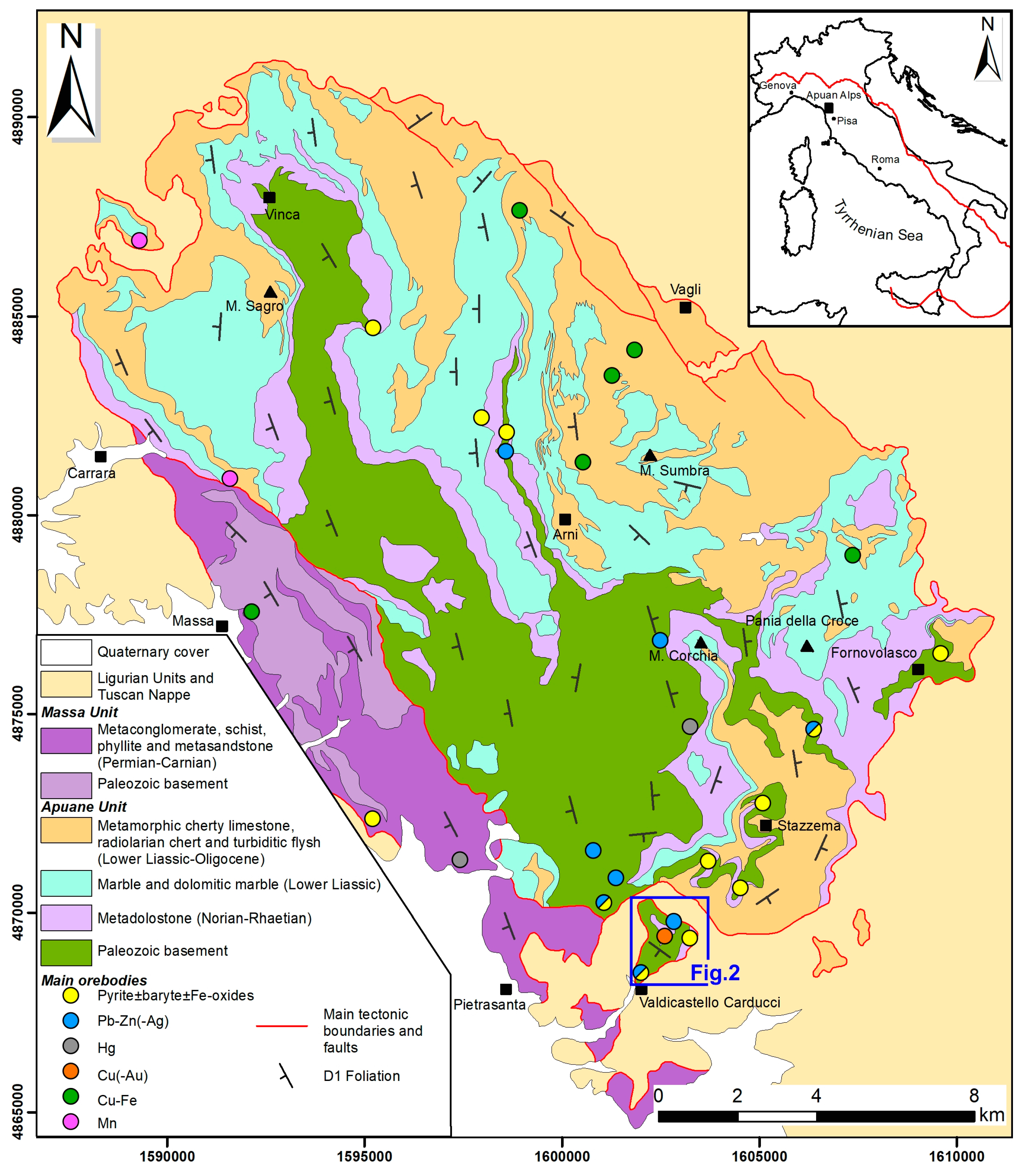
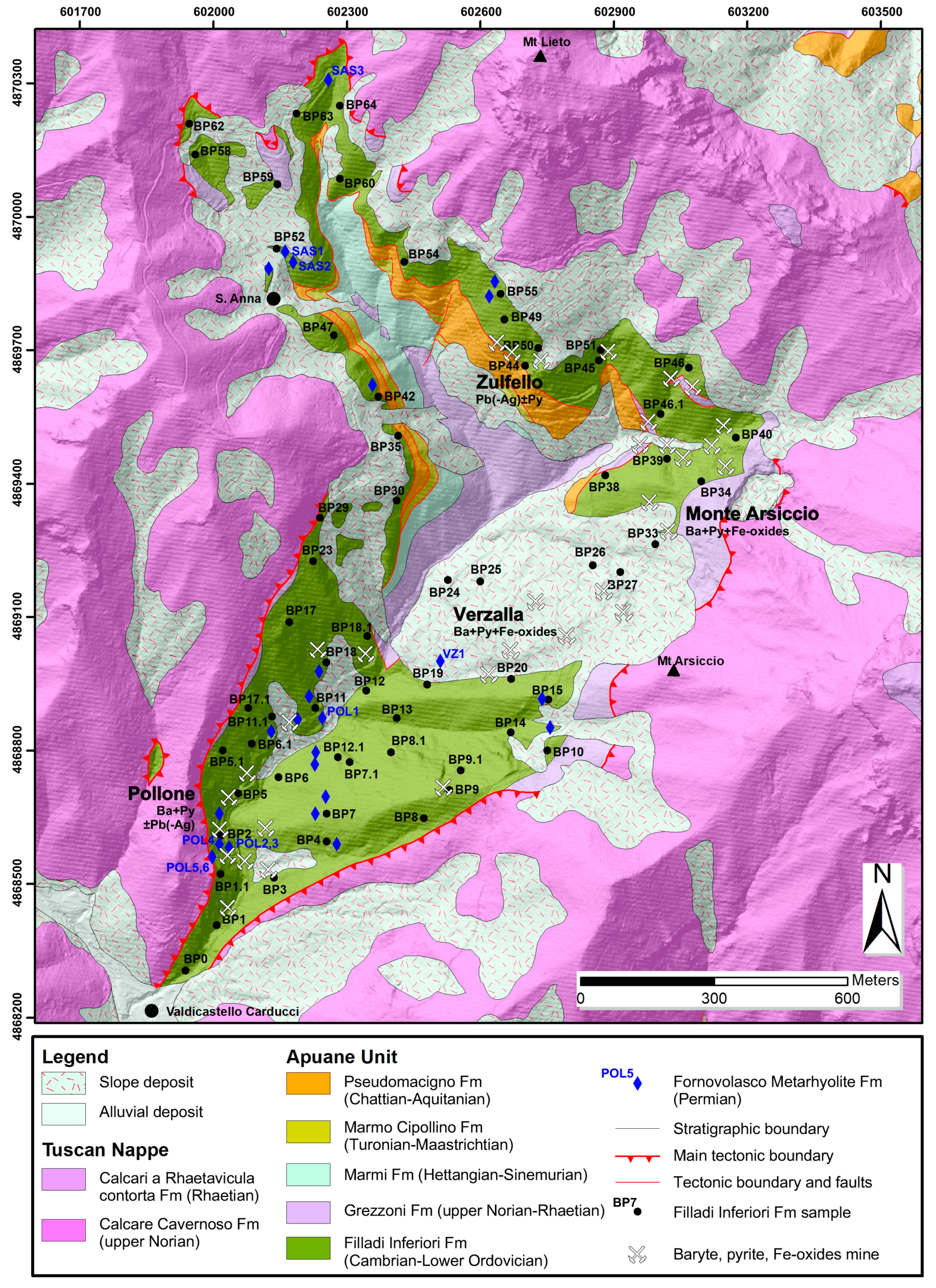
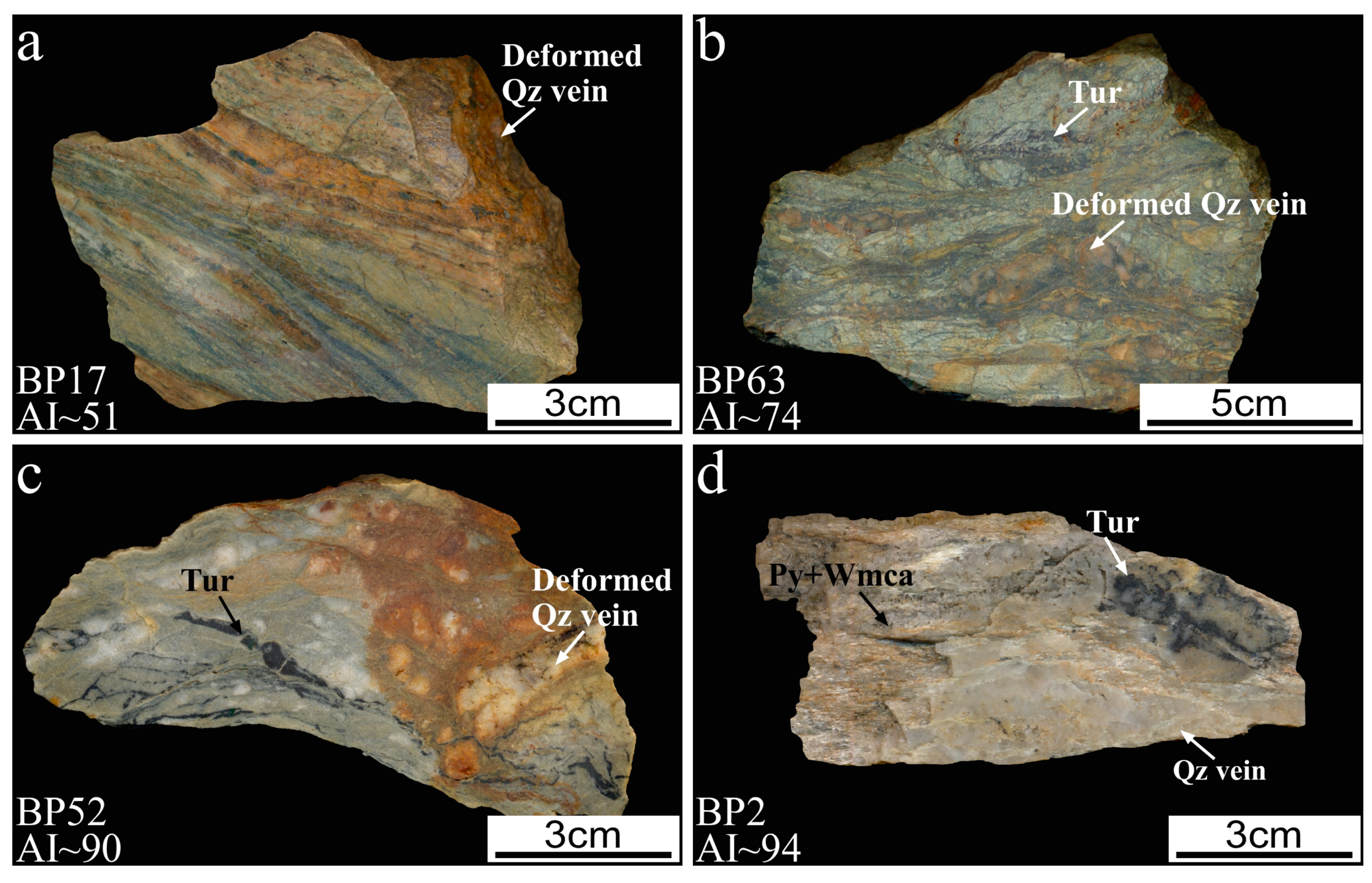
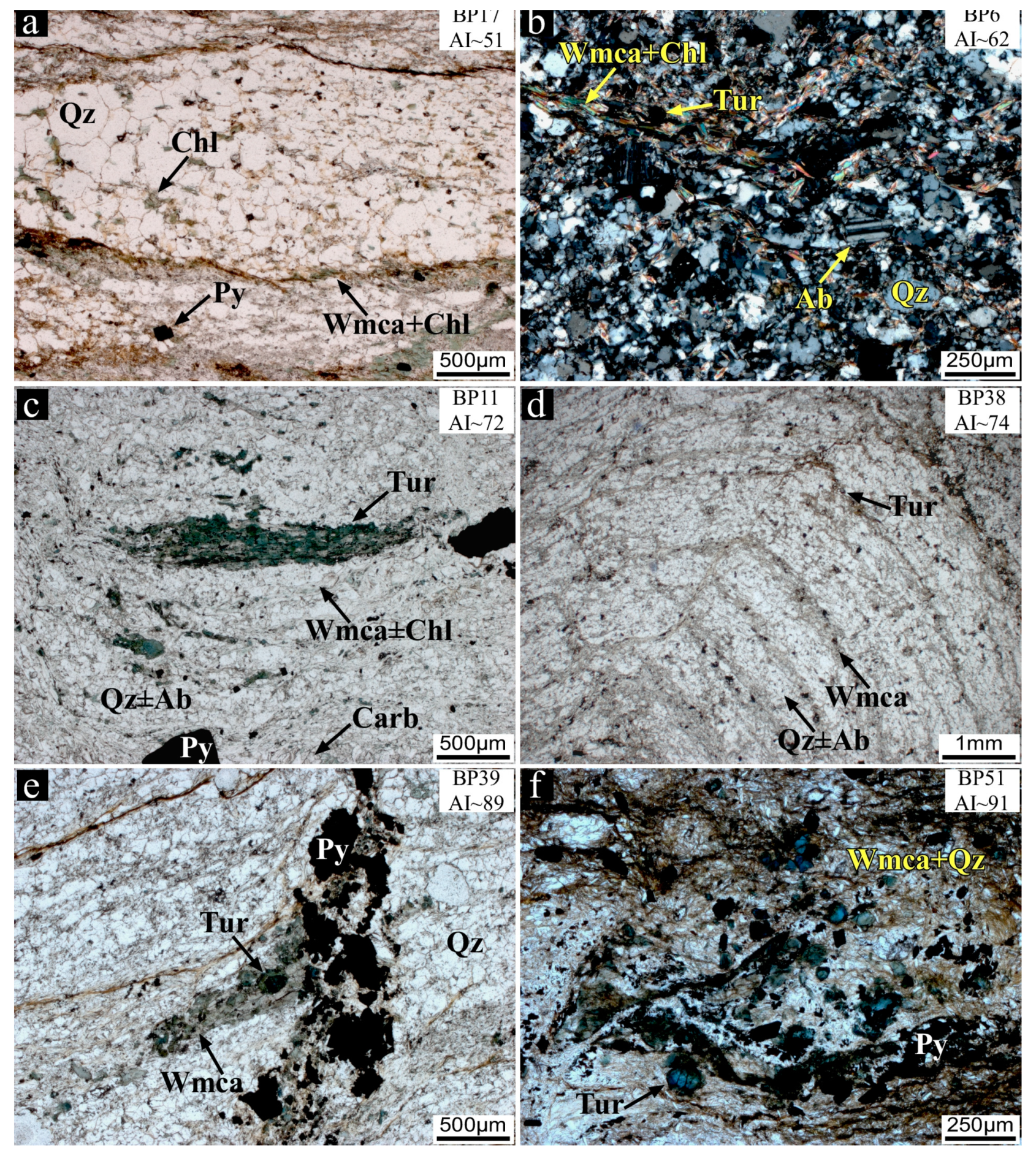

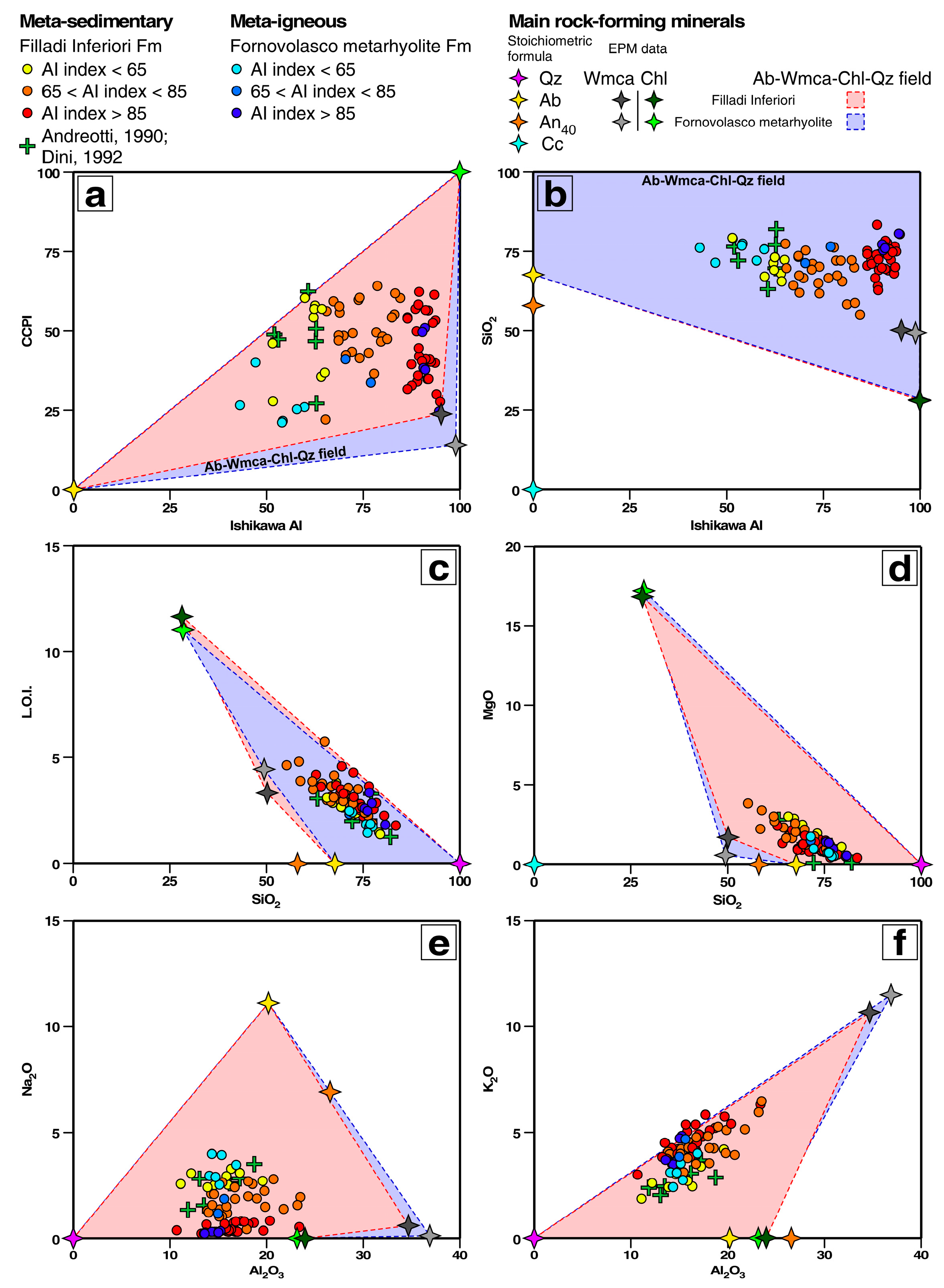
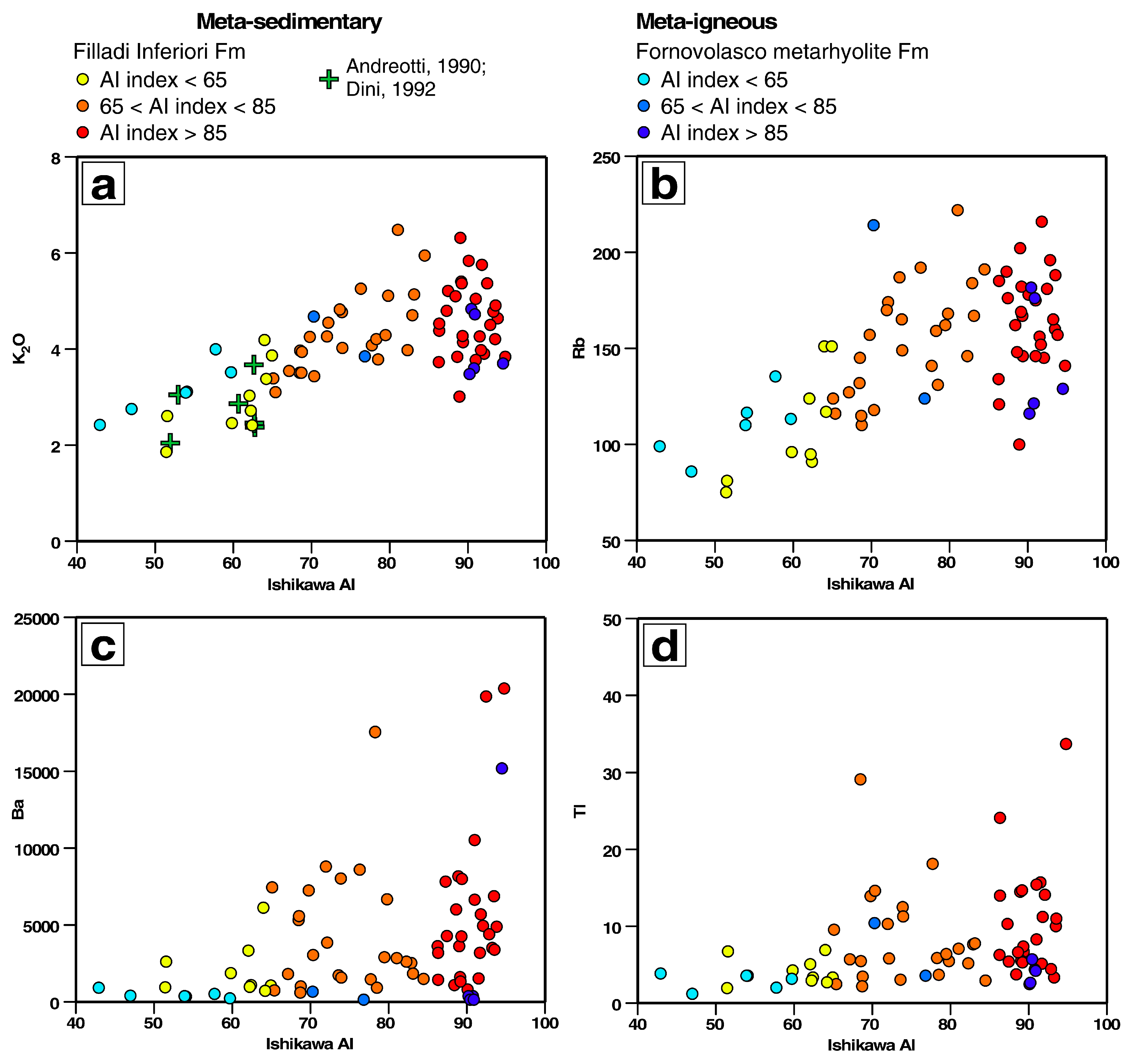
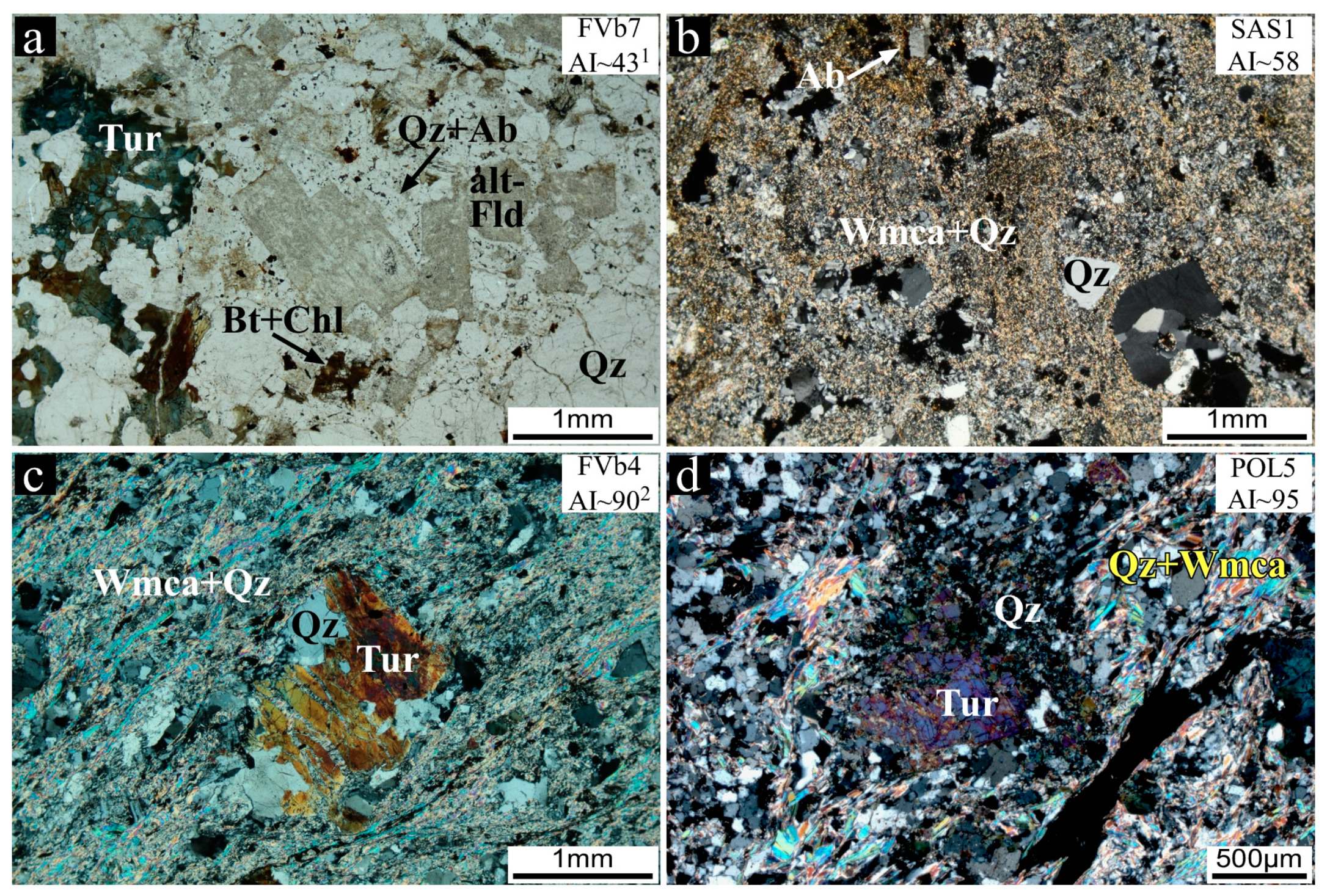
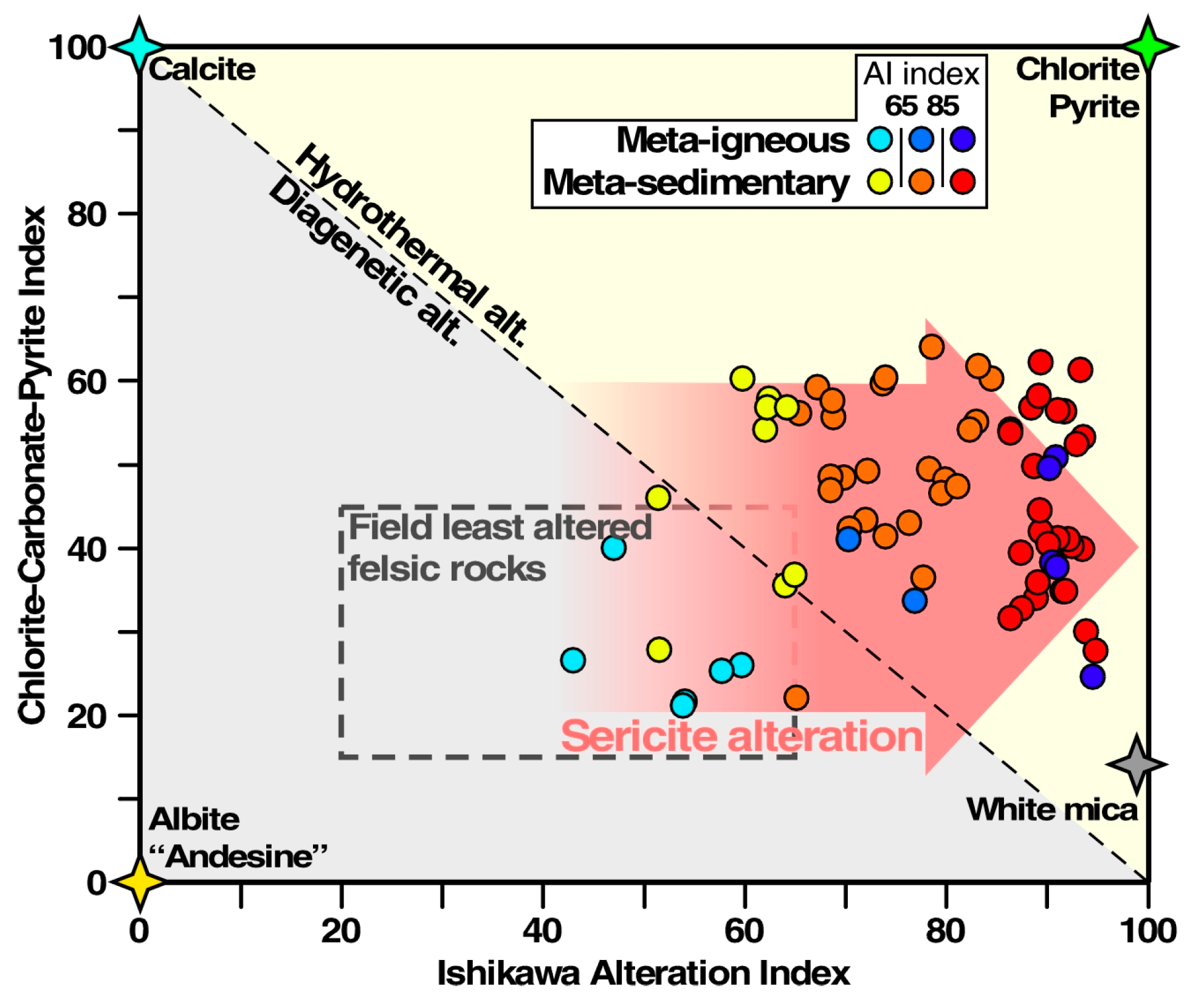

© 2020 by the authors. Licensee MDPI, Basel, Switzerland. This article is an open access article distributed under the terms and conditions of the Creative Commons Attribution (CC BY) license (http://creativecommons.org/licenses/by/4.0/).
Share and Cite
Vezzoni, S.; Pieruccioni, D.; Galanti, Y.; Biagioni, C.; Dini, A. Permian Hydrothermal Alteration Preserved in Polymetamorphic Basement and Constraints for Ore-genesis (Alpi Apuane, Italy). Geosciences 2020, 10, 399. https://doi.org/10.3390/geosciences10100399
Vezzoni S, Pieruccioni D, Galanti Y, Biagioni C, Dini A. Permian Hydrothermal Alteration Preserved in Polymetamorphic Basement and Constraints for Ore-genesis (Alpi Apuane, Italy). Geosciences. 2020; 10(10):399. https://doi.org/10.3390/geosciences10100399
Chicago/Turabian StyleVezzoni, Simone, Diego Pieruccioni, Yuri Galanti, Cristian Biagioni, and Andrea Dini. 2020. "Permian Hydrothermal Alteration Preserved in Polymetamorphic Basement and Constraints for Ore-genesis (Alpi Apuane, Italy)" Geosciences 10, no. 10: 399. https://doi.org/10.3390/geosciences10100399





